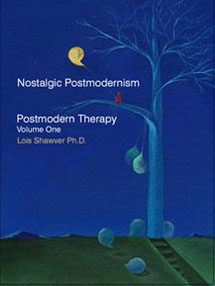| I Autori | Testi | Teorie | Costrutti Teorici | Articoli | Servizi | Associazione | Lavoro | Arte | Cerca nel sito | Iniziative | Collegamenti | Mappa |
|
||||||||||||||||||
Nostalgic Postmodernism. Volume One
Lois Shawver

pagine 144
18,60 euro
2006
Paralogic, Oakland
Nostalgic postmodernism is what people feel when they lose faith in institutionalized "practices" but are uncomfortable with their own creative spontaneity.
Postmodern Therapists
There are many therapists who fit this profile although most of them do not recognize themselves as such. After all, one can be postmodern without knowing it, just as one might be nostalgic without knowing it. A therapist can also do a postmodern kind of therapy without knowing it. At the very least postmodern therapists are eclectic, ready to listen to clients more than to talk, and willing to change their minds based upon what they hear.
Still, such therapists may not recognize themselves as postmodern because to self-recognize one needs a little familiarity with basic postmodern concepts.If the concepts of "postmodernism" or "nostalgic postmodernism" are new to you, this book should change that, but the very fact that you have found yourself at this site and have read this far, suggests there is a strong possibility that you are postmodern, nostalgic or not.
Why Some Therapists Are Postmodern
Nostalgic Postmodernism will also show you how very natural it is for you to be postmodern at this point in western history. We live on the edge of rapid change -- especially since 1989 with the remarkable invention of the internet. You have been exposed to so many theories, to so many theorists arguing they have the answers -- compare your experience today with that of the therapist fifty years ago who was trained in a single school and who did not log online to see an array of competing schools.
And there is much else that is moving many therapists into a postmodern posture -- just as all of the west is increasingly postmodernizing. This change has something to do with our globalization and our increased awareness that there are many ways of making a life in this world. Most important, the postmodernization of therapy is not occurring independently of a similar trend in the wider culture. Many of our clients are more postmodern, too, today. Therapists would be out of step to continuing doing therapy as our grandfathers did.What We Can Do
There is no cure for postmodernism. It would be like curing enlightenment. You have seen the Wizard of Oz. You know he is neither a magician nor an evil culprit. What there is a cure for is your nostalgia. What you need for that is, however, quite simple. You need friendly colleagues who feel similarly to you, and perhaps a few books to help you make sense of your postmodern turn.
The process can be started on this website. Look around. Check out the book, but also check out resources. The resources include a way to join a postmodern therapy community hosted by the author of this book, and more.
Nostalgic Postmodernism is a paperback, 144 pages long, with 239 references. It includes a subject and a name index. You can, therefore, read and study the book as a scholarly text -- but as you can see from excerpts, it is written in a popular and personal style, author to reader, with reflections on the author's long practice (since 1976) as well as on her conversations with other therapists whom she considers postmodern.
The book begins with a chapter that portrays a postmodern therapist in a fictionalized example. That first chapter is followed by an account of the west meant to clarify why western postmodernism is more than a minor phase in the course of history. The third chapter gives you the story of the term and concept "postmodern" as well as its evolution. After reading that third chapter you should feel confident talking with people who define the term in a different way. The final chapter describes the history of therapy as it relates to the postmodernization of therapy. Each chapter is surrounded by a personal commentary on how that chapter came to be written.The author of Nostalgic Postmodernism is a clinical psychologist who has long worked as a therapist (since 1976). While this is her second book, it is her first book on postmodern therapy. A list of chapters she has written for other books, as well as articles she has published in journals on the topic of postmodern therapy, is provided through the tab above called "resources".
Indice
Becoming Postmodern
How the West Became Postmodern
What is "the Postmodern"?
Why Therapy is Becoming Postmodern
Epilog
References
Subject Index
Name Index